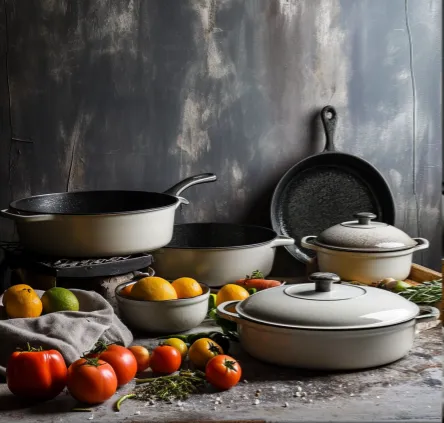- 150m Southwards, West DingWei Road, Nanlou Village, Changan Town, GaoCheng Area, Shijiazhuang, HeBei, China
- monica@foundryasia.com
Dec . 09, 2024 22:09 Back to list
Exploring the Heritage of the Renowned Iron Tawa Cooking Pan
The Famous Iron Tawa Pan A Culinary Essential
In the world of cookware, few items hold as much cultural significance and practical utility as the iron tawa pan. This versatile kitchen tool is a time-honored staple, particularly in Indian households, where it has been used for generations to create a wide variety of dishes, from flatbreads to stir-fries. The iron tawa pan is celebrated not just for its functionality, but also for the rich heritage and culinary practices it encapsulates.
The Anatomy of an Iron Tawa Pan
Typically round and flat, the iron tawa pan features a slightly raised edge, making it ideal for cooking a variety of dishes without fear of spillage. Made of cast iron, the tawa offers excellent heat retention and even heat distribution, which are essential for creating perfectly cooked meals. Its weighty design ensures that it can withstand high cooking temperatures, making it suitable for various cooking methods, including frying, roasting, and sautéing.
One of the most distinctive features of an iron tawa pan is its ability to develop a natural non-stick surface over time. When seasoned properly, the surface becomes increasingly resistant to sticking, which enhances the cooking experience and makes cleanup easier. This natural patina is achieved through the application of oil and repeated use, embodying the adage that a well-loved pan only improves with age.
Culinary Versatility
The iron tawa pan is primarily associated with making Indian flatbreads such as chapati, paratha, and dosa. The high heat retention of the pan ensures that these breads puff up beautifully and develop a delightful char, giving them their characteristic texture and flavor. However, its versatility extends far beyond bread-making. The tawa can also be employed to cook vegetables, meats, and even pancakes, allowing for a diverse range of recipes to be prepared with a single tool.
Moreover, the iron tawa is often used for shallow frying and crisping snacks like samosas and pakoras. The ability to maintain consistent heat makes it an excellent choice for achieving the perfect golden-brown finish on fried foods, enhancing their crunch and flavor. Its flat surface also makes it ideal for roasting spices while cooking, allowing for an authentic depth of flavor that is vital in traditional Indian cooking.
famous iron tawa pan

Health Benefits of Cooking with Iron
Cooking with an iron tawa pan is not only practical but also healthful. Cast iron cookware naturally leaches small amounts of iron into food while cooking, which can be especially beneficial for individuals with iron deficiency. This essential mineral plays a crucial role in maintaining energy levels and overall health. For families looking to improve their iron intake, incorporating meals prepared in an iron tawa pan can be a simple yet effective strategy.
Additionally, the absence of synthetic coatings or harmful chemicals in cast iron pans adds a layer of safety to cooking. Unlike some non-stick pans, which can release toxic fumes when overheated, an iron tawa is completely safe and can be used at high temperatures without concern.
Caring for Your Iron Tawa Pan
While the iron tawa pan is an incredibly reliable tool, it does require some care to maintain its quality and functionality. Proper seasoning is vital; after each use, the pan should be washed with minimal soap and dried thoroughly to prevent rust. A light coating of oil post-cleaning helps keep the surface seasoned and ready for the next culinary adventure.
Over time, you may notice some discoloration or a drop in non-stick performance. This is usually a sign that the seasoning layer needs to be replenished. A simple process of reseasoning involves cleaning the pan, applying a generous amount of oil, and baking it upside down in the oven for an hour. This not only restores its non-stick properties but also extends its life significantly.
Conclusion
The famous iron tawa pan is more than just a piece of cookware; it's a vessel of tradition, health, and versatility. By incorporating this time-honored tool into your kitchen, you not only enhance your culinary repertoire but also honor a rich culinary legacy that transcends generations. Whether you are whipping up a quick roti for breakfast or preparing a feast for family and friends, the iron tawa pan stands as a testament to the art of cooking. Investing in one is not just a purchase—it's an embrace of history, culture, and a healthier lifestyle.
-
Premium 2 Quart Enameled Cast Iron Dutch Oven | AI-Enhanced
NewsAug.02,2025
-
Premium Enameled Cast Iron Sauce Pan Cover | Even Heat
NewsAug.01,2025
-
Pre-Seasoned Cast Iron Wok - Fast Heat & Durable
NewsJul.31,2025
-
Best Cast Iron Skillet for Grill with GPT-4 Turbo
NewsJul.31,2025
-
Best Cast Iron Skillet for Outdoor Grill – Versatile & Lightweight Options
NewsJul.30,2025
-
High-Quality Iron Dutch Oven Pot for ODM & OEM Solutions
NewsJul.29,2025